Cooking with Intizar Husain
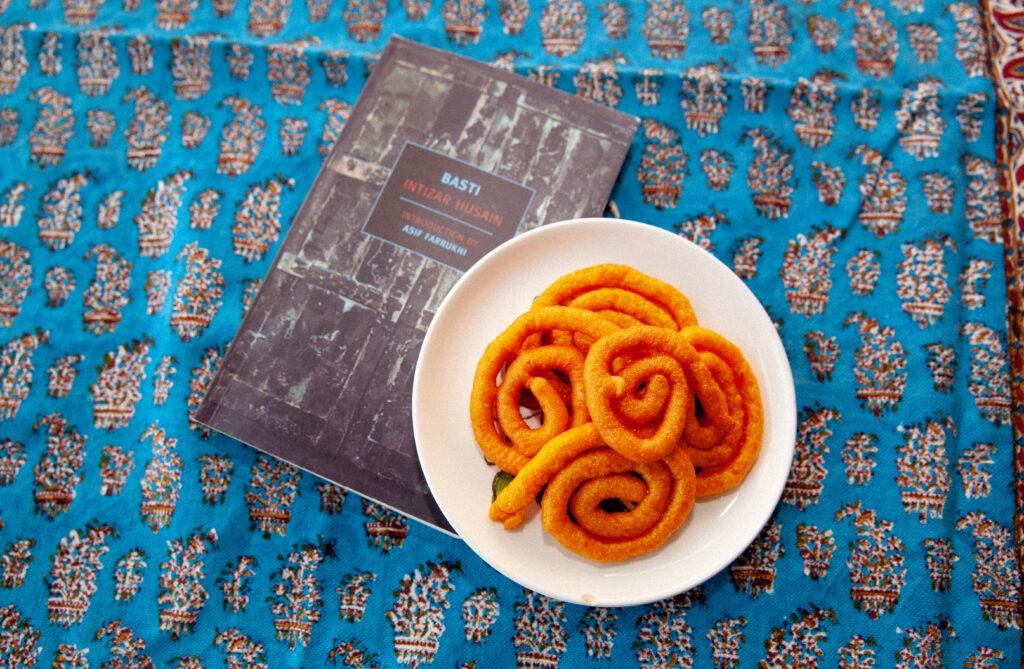
Photo by Erica Maclean.
The novel Basti by Intizar Husain begins with children in the fictional village of Rupnagar— which means beautiful place in Urdu—shopping for staple foods like salt and brown sugar. Trees here breathe “through the centuries,” time “speaks” in the voices of birds, the world is new, and the sky is fresh. From a distance, elephants look like mountains moving. For the children, including the novel’s protagonist, Zakir, one source of information about the world is the town shopkeeper, Bhagat-ji, a Hindu; Zakir’s father, Abba Jan, a Muslim, is another. Bhagat-ji tells them that elephants could once fly and are hatched from eggs. Abba Jan, who is referred to as Maulana, a respectful term for a man of religious learning, tells them the earth is shaped from the expanding ocean and the ocean’s water came from a single pearl. Together their voices weave a tapestry of life that will be torn asunder in 1947 by the partition of India.
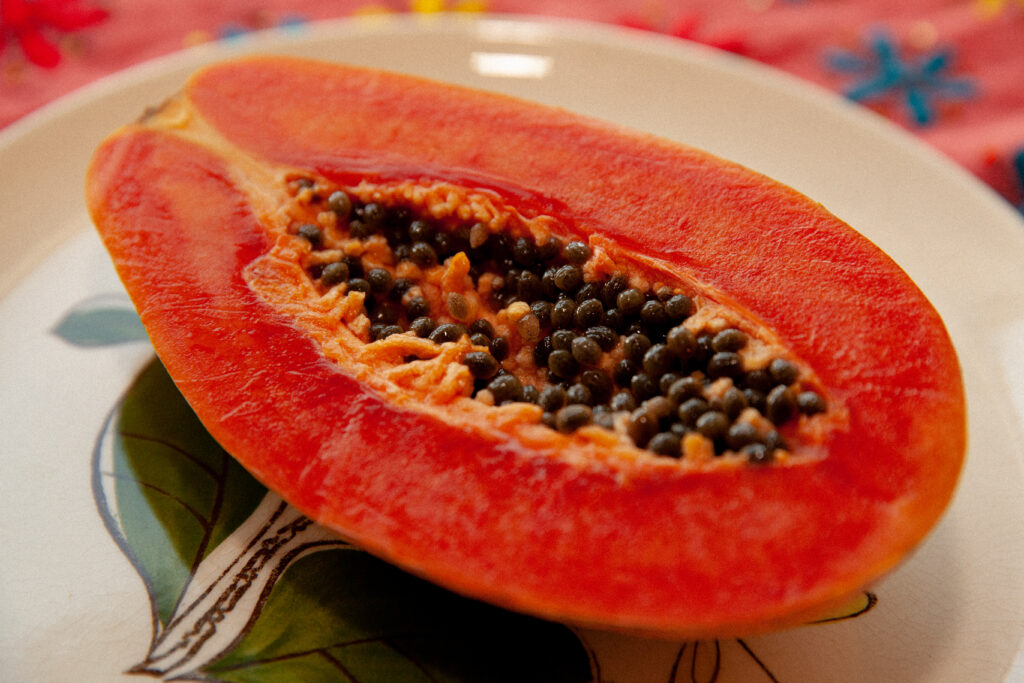
Ingredients drawn from the work of Intizar Husain had the lushness and beauty of his descriptions of Zakir’s childhood village. Photo by Erica Maclean.
“Partition set in motion a train of events unforeseen by every single person who had advocated and argued for the division,” writes the historian Yasmin Khan. The intention of local leadership and the British Raj was that the two new states of India and Pakistan would allow for Hindu and Muslim self-rule in Hindu- and Muslim-majority areas. But loosely organized violence against minority populations on both sides led to the mass migration of ten to twenty million people to the countries run by their co-religionists, with an estimated 500,000 to three million killed. These killings occurred with what Khan calls “indiscriminate callousness” that included widespread disfigurement, mutilation, and rape. Conflict between India and Pakistan is ongoing to this day. Most scholarship, Khan argues in her book The Great Partition, has largely viewed these events as historically and culturally isolated, but she makes a compelling argument for locating it within “wider world history.”
The main narrative in Basti, which I read in a translation from the Urdu by Frances W. Pritchett, starts two decades after Partition, with Zakir abruptly recalled to his childhood memories by “the sound of slogans being shouted from outside” in Lahore. Zakir is an adult; his family has left the paradise of Rupnagar for the promise of Pakistan. It’s the early seventies, a time of political turmoil between the western and eastern halves of the country that led to further sundering and to a war with India. (East Pakistan became Bangladesh during this period.) Zakir has become a professor, but the buildup of violence closes the university, casting him adrift into a world of memory, history, and myth. “The rain poured down all night inside him,” Husain writes. “The dense clouds of memory seemed to come from every direction.”
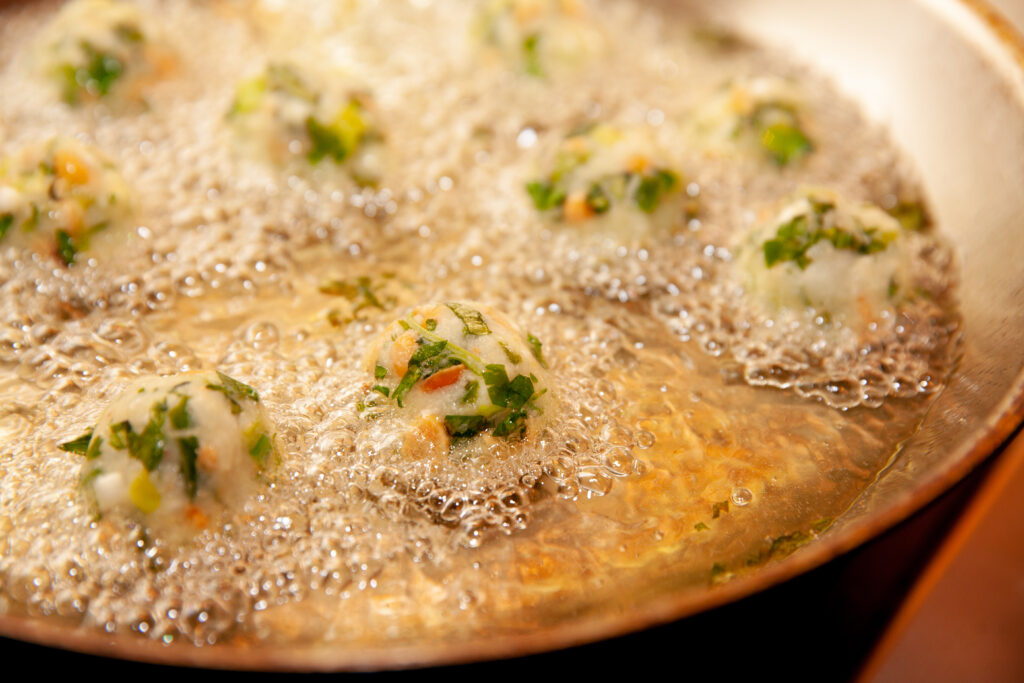
In Zakir’s childhood memory, his aunt calls out to his cousin “ ‘Daughter, how long are you going to swing? Come and do some frying. Make a few fritters.’” I fried tapioca balls. Photo by Erica Maclean.
What follows is a lyrical, formally experimental novel that refuses to stay put in the past or present. Zakir inhabits a phantasmagoric city wracked by violence, where a changing cast of characters ebbs and flows through the cafés at night. Their voices, alongside religious lore, create an ambiguous terrain where political certainties vanish. The narrative point of view elides most information about the conflict and reduces all politics to indefinite “slogans.” This was controversial among some of Husain’s contemporaries, who were “attached to a politically activist concept of literature,” as the Pakistani writer Asif Farrukhi notes in his introduction to the NYRB edition of Basti. Critics objected to the book’s lack of a “clear political perspective” and “resolution,” Farrukhi says, or claimed that it was too nostalgic and negative. But Husain identified polarization as the engine of tragedy, and he declined to participate in it. When one character asks, in sorrow and bewilderment, “Yar, was it good that Pakistan was created?,” Zakir remains silent. Another character replies, “I know one thing, in the hands of the wrong people, even right becomes wrong.”

A mango tree in the school grounds is a landmark in Rupnagar. A Hindu friend who stays in India writes wistfully to Zakir about it as an adult. My tree-fruit lassis were in its honor. Photo by Erica Maclean.
Zakir is not comfortable in his new home; he cannot grow attached to it. Other characters feel the same way. His mother dreams of the locked room full of the family’s treasures that they left behind in their house in Rupnagar when they fled for Pakistan. In a café, Zakir’s friend Afzal tells him about his grandmother, whom Afzal’s family could only convince to leave by telling her their former home was flooding. Repeatedly, she says, “My child, the flood must have gone down, let’s go home.” When Afzal tells her they’re never returning, she looks at him, says “All right,” and dies. Old social structures, too, cannot be rebuilt in the new place. Husain spills little ink on the British, the original disruptors of local structures.
Some of the losses were culinary. The new land is rootless and anti-sensual. The characters in Basti drink endless tea, but they don’t eat much. Most references to food are located in the past: in Rupnagar there were fritters and ginger chips and dishes of rice cooked in milk. In nearby Bulandshahr, where Zakir goes with a young woman whom he loves—he will lose her during Partition—the neighborhoods “are known by their atmospheres.” Zakir first holds her hand in a place where “the lanes in which huge cauldrons of sugar bubbled on big cooking stoves were so full of smoke and wasps that it was hard to walk through them.” In the present day, by contrast, even the foods are displaced. In Lahore, Husain several times mentions jalebi, a kind of fried dough soaked in sugar syrup that is popular with “Easterners who came out of Meerut” during the war. Like most political details, the significance of the Easterners to the war effort is left vague. But Zakir observes that “the city’s snack-sellers are tired of the Easterners. They eat different kinds of sweets, they take marijuana, they demand jalebis along with their snacks.” Set loose from place, time and history, such foods are stripped of their power and sensuality.

A simple recipe for papaya lassi produced a unique, smoky-flavored drink. Photo by Erica Maclean.
Reading Basti cast my experience of Indian cuisine—which I make frequently—in a new light; I began to think more clearly about regionality. My treasured sources are two cookbooks published in the eighties by Julie Sahni, a Brooklynite from India. In Sahni’s Classic Indian Cooking, she explains that the countries of India, Pakistan, Bangladesh, Myanmar, and Sri Lanka occupy “the clearly bounded Indian subcontinent.” The prefaces to her recipes include notations on the dish’s place or people of origin, and emphasize the shared cultural threads that run through the particular region. The recipes in her books feel unified, but there is also value in knowing that the regions of Bengal and Punjab, frequent sources of her wonderful recipes, are now split into East and West territories—Bengal in Bangladesh and India, and Punjab in India and Pakistan.
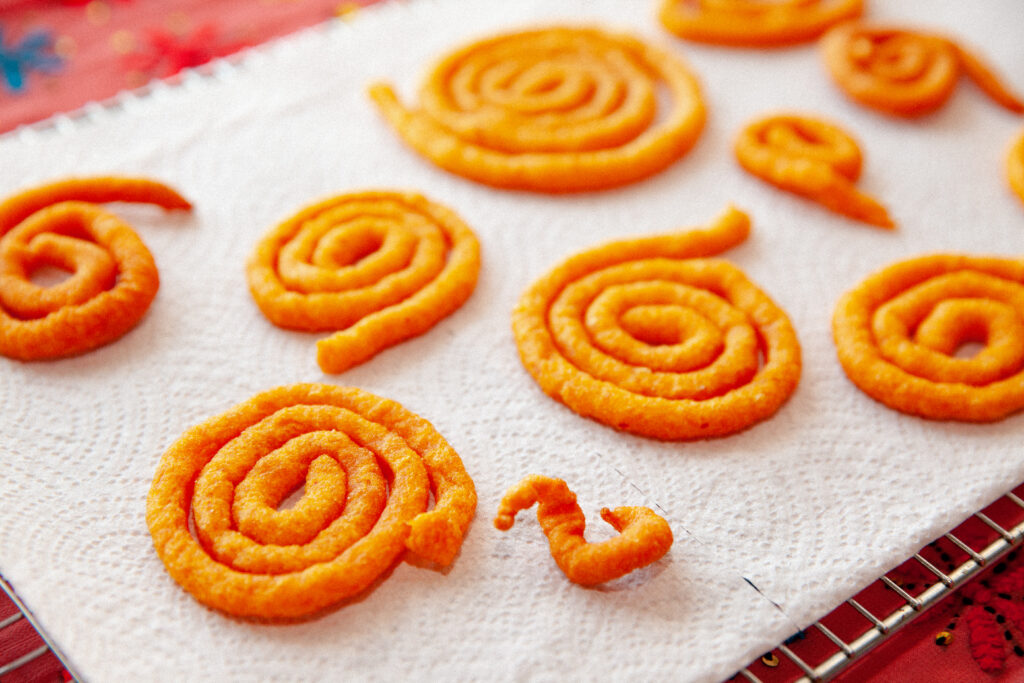
Sahni writes that she loved jalebis as a child, and notes that in North India they’re served as a breakfast treat accompanied by scalded milk. Photo by Erica Maclean.
I decided to make jalebis along with a spicy tapioca and peanut croquette, a “snack” that Sahni suggested as a good accompaniment for them; in her mix-and-match way, the croquette and the jalebis are from different regions. And because trees frequently appear in Basti as Husain mourns rootedness, I chose to make two lassis from tree fruits: a mango version inspired by a mango tree in Rupnagar, and a papaya one inspired by a papaya tree mentioned in Lahore. Sahni’s book specifically suggests the light and salty papaya drink is a good chaser for jalebis (in her version spelled jalaibees).
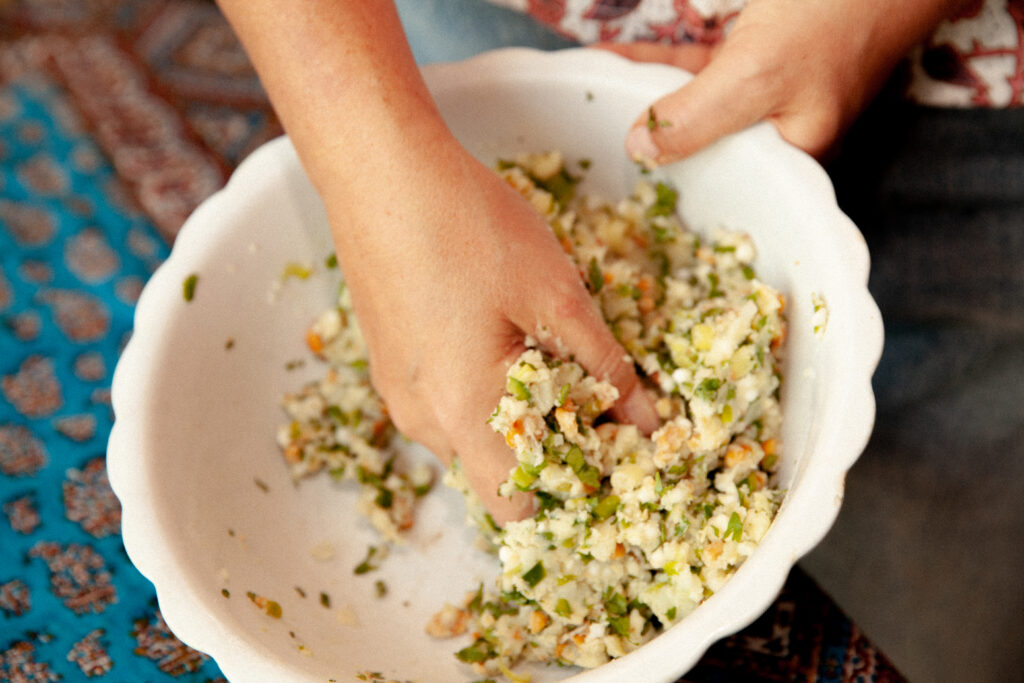
I struggled to execute some of Husain’s food, but the croquette mixture turned out well. Photo by Erica Maclean.
The cooking process channeled Husain’s vision in unexpected ways. Basti is a profoundly sorrowful book, in which Zakir finds that the most authentic response to violence is to “take up the trust” of defeat. No kitchen disaster could compare, but I was roundly defeated in my attempt to make jalebis. Made correctly, the snack is a spiral of fermented, fried dough, briefly soaked in an orange-colored sugar syrup. It is supposed to be light, crispy, and very sweet. On my first try I missed the note about fermentation, and on my second try I still failed to understand that the syrup, not the dough, was supposed to be colored. The unfermented dough was floppy and difficult to pipe, and it didn’t really crisp up. The fermented version had a delicious raw batter and handled better, but once fried it still didn’t absorb the syrup as I might have wished. I’ve often struggled to execute Sahni’s more complex recipes, which often hit you with an additional sauce or lengthy second simmer just when you think you’re done, and this was no different. I was fortunate that the potato croquettes were the other type of Sahni special—wildly flavorful, unique in taste and texture, and fairly accessible to the American home cook. The finished balls were spicy, nutty, pillowy, chewy, and herby. I forgot to flatten them into the correct shape, but that was a minor flaw. My lassis were also hit-and-miss. The papaya drink called for buttermilk instead of yogurt and had an unexpected salty, smoky melon flavor that made it the star of the day. The mango drink was refreshing, but the mango wasn’t very ripe, and the results were less sweet and flavorful than the restaurant versions.
In addition to my user errors on the recipes, I broke things while cooking from Basti to an unprecedented extent: a blender, a vegetable peeler, and a Pyrex measuring cup I’d thought to be indestructible, lost to a round of boiling sugar syrup. I also destroyed two reusable plastic piping bags by squeezing too hard, and put the quarter-inch round piping tip used to make the spirals through the disposal (ruinous to the tip, questionable for the disposal). The disasters were so comically many that they seemed like a pointed message on the fragility of the things we take for granted—not our Pyrex, but our political structures and our peace.
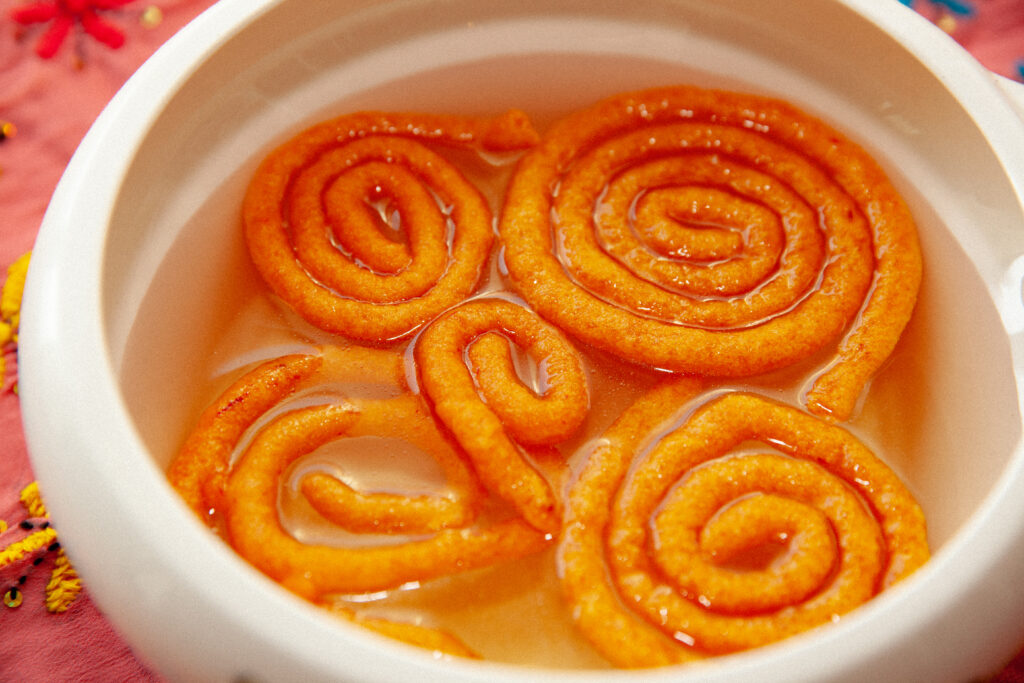
Photo by Erica Maclean.
Crisp Jalaibees in Sweet Syrup
Adapted from Classic Indian Vegetarian and Grain Cooking by Julie Sahni.
Note: This recipe requires you to start fermentation twenty-four hours in advance.
2 ¼ cups flour
¼ cup chickpea flour
¼ tsp baking powder
2 tbsp plain yogurt
½ tsp turmeric
1 ½ cups hot water
½ tsp powdered saffron threads
Several drops of orange gel food coloring, if desired
¼ cup rice flour
2 cups of sugar
Peanut or corn oil to fill a frying pan to a depth of 2 inches.
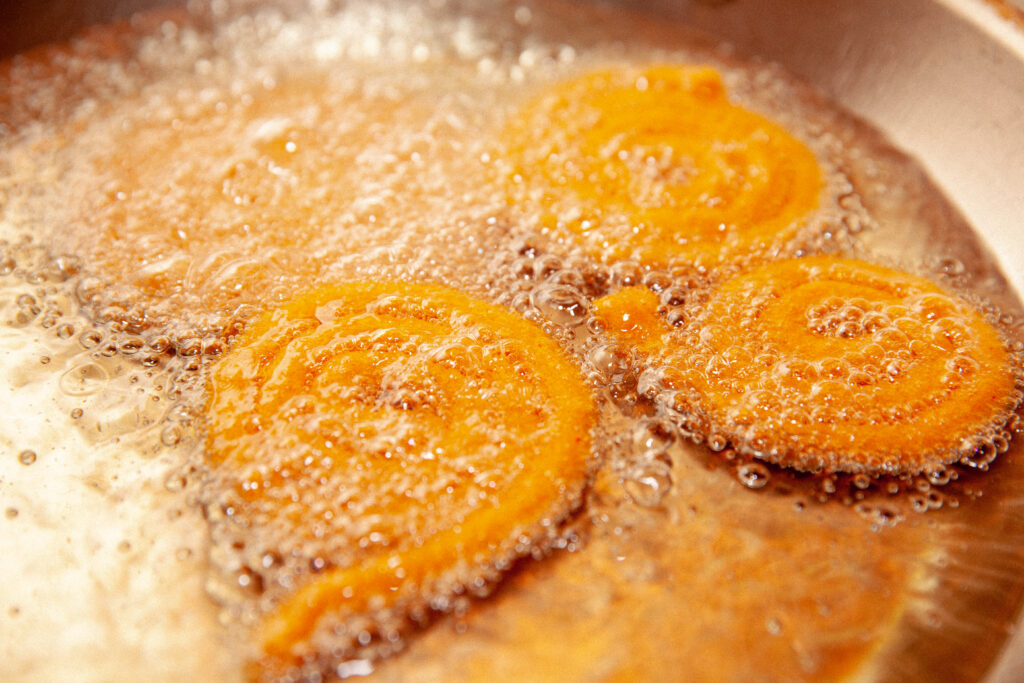
Photo by Erica Maclean.
Mix two cups of the flour with the chickpea flour, baking powder, and yogurt. Add the hot water and mix to form a paste. Cover and set aside in a warm place for twenty-four hours to ferment. (I put mine in the microwave with the light on, which provides the necessary warmth for fermentation in a cold Northeastern climate.)
When ready to make the jalaibees, stir in the remaining quarter cup of flour and the rice flour. Heat the sugar with two cups water in a small saucepan and bring to a boil. Add the saffron powder and turmeric. The syrup should be a bright and synthetic-looking orange; if it is still pale in color, add in some orange food coloring. Set aside.
Heat the oil over medium heat to a temperature of 350°F. (Do not be tempted to use less than the full two inches of oil, or you won’t have enough oil in the pan to maintain a consistent temperature.) Fit a pastry bag with a quarter-inch round writing tip and fill with the dough. When the oil is hot, squirt the batter into the hot oil in a swift, spiral movement, about three turns to make a spiral of four inches in diameter. Make three or four such circles. Let them fry for two minutes until lightly browned. Turn and fry for another half minute. Remove the jalaibees with tongs and press them flat in the syrup. Let soak for fifteen to thirty seconds. Remove and set aside to drain on a wire rack. Repeat with the remaining batter in the same way. Reserve the oil to use for the next dish.
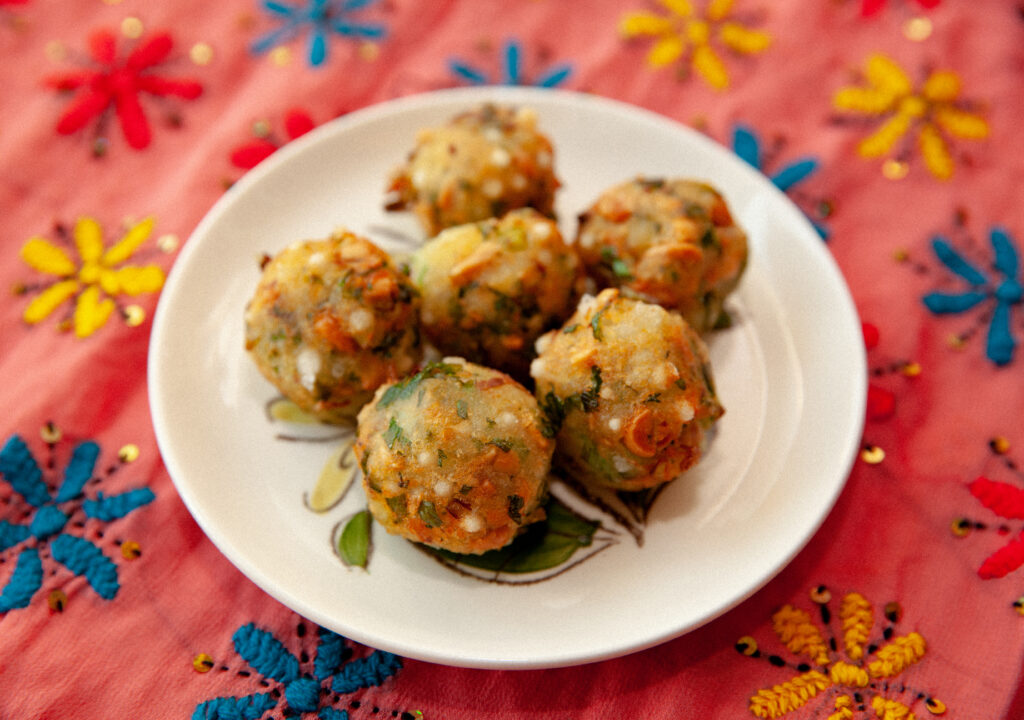
Photo by Erica Maclean.
Fiery Hot Tapioca and Peanut Croquettes
Adapted from Classic Indian Vegetarian and Grain Cooking by Julie Sahni.
6 tbsp tapioca pearls
8 hot green chilies, finely chopped (or fewer, to taste)
½ cup fresh coriander, leaves and stem, finely chopped
½ cup roasted, salted peanuts, chopped
3 medium size potatoes (about ¾ lb), boiled, peeled, and coarsely mashed
½ bunch scallions, green and white parts, chopped
¼ tsp ground asafetida
Peanut or corn oil, enough to fill a skillet to a depth of 2 inches
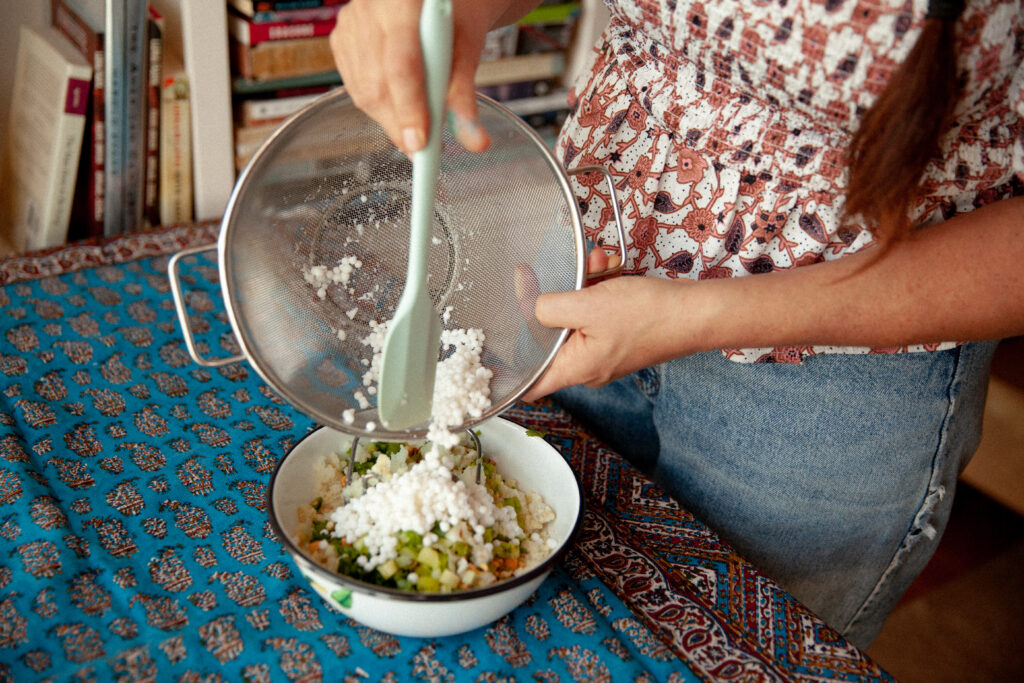
Photo by Erica Maclean.
Place tapioca in a small bowl and rinse three or four times to wash away excess starch. Add enough water to cover the tapioca by an inch and let soak for twenty minutes. Drain, rinse, and drain again. Put in a bowl.
Add the remaining ingredients except for the oil, and mix thoroughly, kneading the mixture with your hands. Clean your hands and moisten them slightly to prevent the mixture from sticking. Pinch off one-inch round pieces of dough and roll into a smooth ball. Press the balls lightly but firmly to flatten them slightly. Set aside.
Heat the oil in a skillet until very hot, about 375°F. Add six or seven of the patties at a time and fry, turning them, until they turn golden brown, about three minutes per side. Drain on paper towels and continue with the rest in the same way.
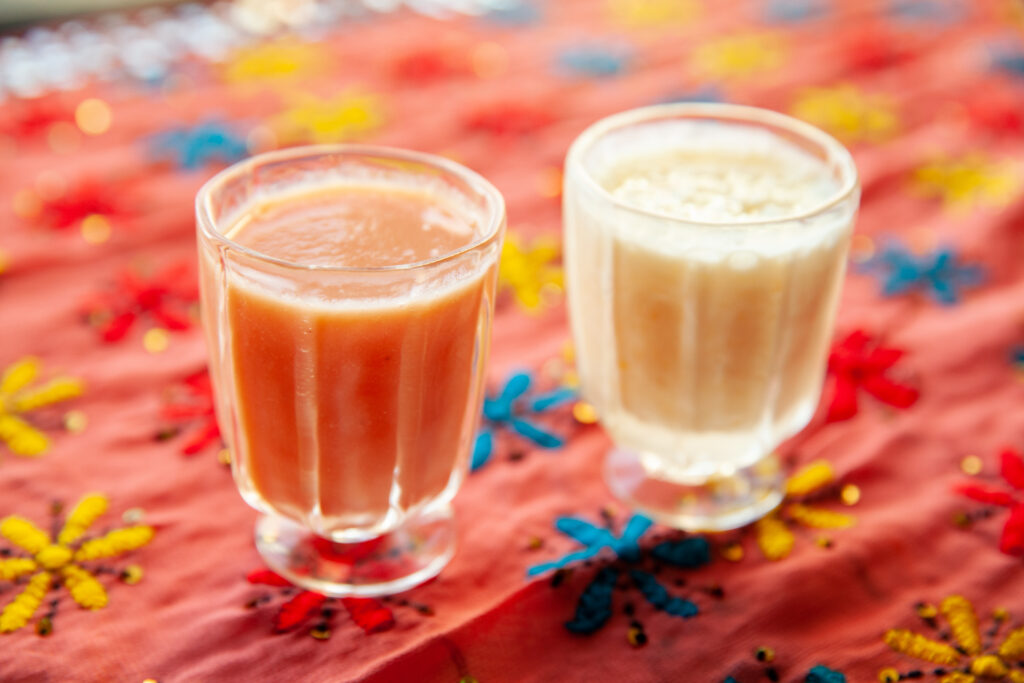
Photo by Erica Maclean.
Mango Lassi
Adapted from Classic Indian Vegetarian and Grain Cooking by Julie Sahni.
1 ¼ cups plain yogurt
½ tsp lemon juice
½ cup mango pulp
⅓ cup cold water
4 tbsp honey or sugar
9-10 standard size ice cubes
Put all ingredients in a food processor or electric blender, and whiz until frothy and combined.
Papaya Lassi
Adapted from Classic Indian Vegetarian and Grain Cooking by Julie Sahni.
Heaping ½ cup ripe papaya, cut into chunks
¾ cup buttermilk
2 tbsp honey or sugar
¼ tsp coarse salt
Pinch nutmeg
¼ cup water
4 standard-size ice cubes
Put all ingredients in a food processor or electric blender, and whiz until frothy and combined.
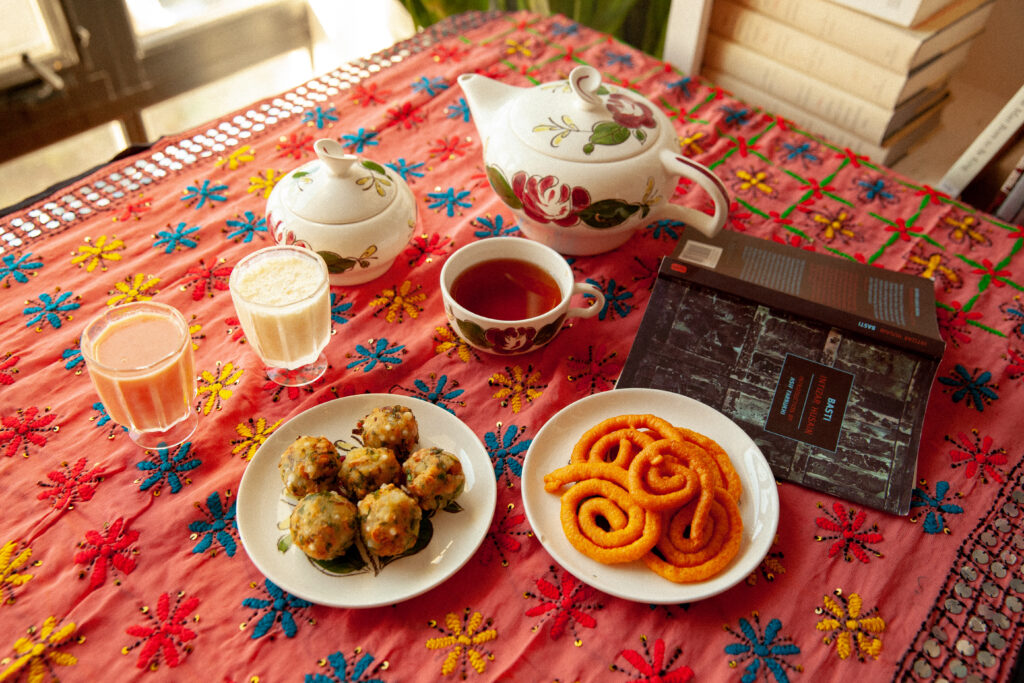
Photo by Erica Maclean.
Valerie Stivers is a writer based in New York. Read earlier installments of Eat Your Words.
Copyright
© The Paris Review
